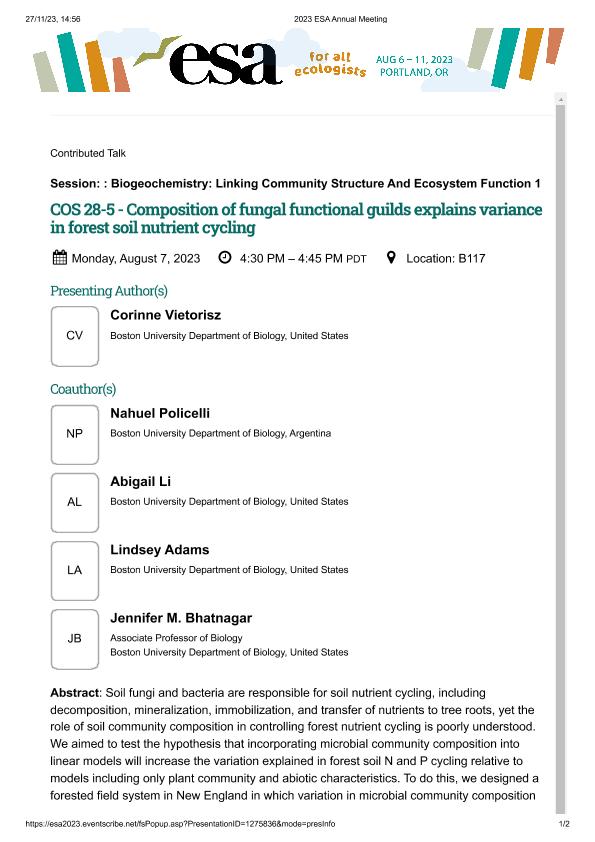Evento
Composition of fungal functional guilds explains variance in forest soil nutrient cycling
Tipo del evento:
Encuentro
Nombre del evento:
ESA 2023 - Meeting of the Ecological Society of America
Fecha del evento:
06/08/2023
Institución Organizadora:
Ecological Society of America;
Título del Libro:
Meeting of the Ecological Society of America
Editorial:
Ecological Society of America
Idioma:
Inglés
Clasificación temática:
Resumen
Soil fungi and bacteria are responsible for soil nutrient cycling, including decomposition, mineralization, immobilization, and transfer of nutrients to tree roots, yet the role of soil community composition in controlling forest nutrient cycling is poorly understood. We aimed to test the hypothesis that incorporating microbial community composition into linear models will increase the variation explained in forest soil N and P cycling relative to models including only plant community and abiotic characteristics. To do this, we designed a forested field system in New England in which variation in microbial community composition was crossed with variation in vegetation composition and soil nutrient content. At six forest sites (three suburban and three rural sites), we sampled soil along a transect from the forest edge to interior from four stand types dominated by trees of varying litter quality: pine-dominated, pure hardwood, hardwood with pines in the understory, and mature mixed pine-hardwood. In each soil sample, we measured inorganic and total nitrogen (N) and phosphorus (P), N and P mineralization rates, and nitrification rates. We also performed high-throughput sequencing of fungal and bacterial rDNA amplicons (16S/ITS) and calculated functional guild abundance for fungi and bacteria in each sample. Excluding microbial factors, N mineralization was best explained in a linear model by pH, soil temperature, soil moisture, % soil organic matter, and the abundance of understory vegetation; nitrification was best explained by pH, the proportion of hardwood litter, the abundance of understory vegetation, and basal area of arbuscular mycorrhizal-associating trees. We found that including the proportion of fungal functional guilds improved linear statistical models explaining variance in rates of N mineralization and nitrification, but not in single point measurements of inorganic N or total P. The proportion of ectomycorrhizal fungi per sample was positively related to N mineralization (p = 7e-05, R2 = 0.128), and including it in the model increased the proportion of variance explained in N mineralization rates by 2.8%. The proportion of saprotrophic fungi per sample was positively related to nitrification (p = 0.001, R2 = 0.083), and including it in the model increased the proportion of variance explained in nitrification rates by 2.0%. These findings suggest that ectomycorrhizal fungi may play a role in N mineralization, while saprotrophs may be more important for nitrification. We are currently building models to explain P mineralization and to improve current models by incorporating bacterial functional guilds.
Palabras clave:
CARBON CYCLING
,
ECTOMYCORRHIZAL FUNGI
,
SOIL MICROBES
Archivos asociados
Licencia
Identificadores
Colecciones
Eventos(IPEEC)
Eventos de INSTITUTO PATAGONICO PARA EL ESTUDIO DE LOS ECOSISTEMAS CONTINENTALES
Eventos de INSTITUTO PATAGONICO PARA EL ESTUDIO DE LOS ECOSISTEMAS CONTINENTALES
Citación
Composition of fungal functional guilds explains variance in forest soil nutrient cycling; ESA 2023 - Meeting of the Ecological Society of America; Portland; Estados Unidos; 2023; 1-2
Compartir




